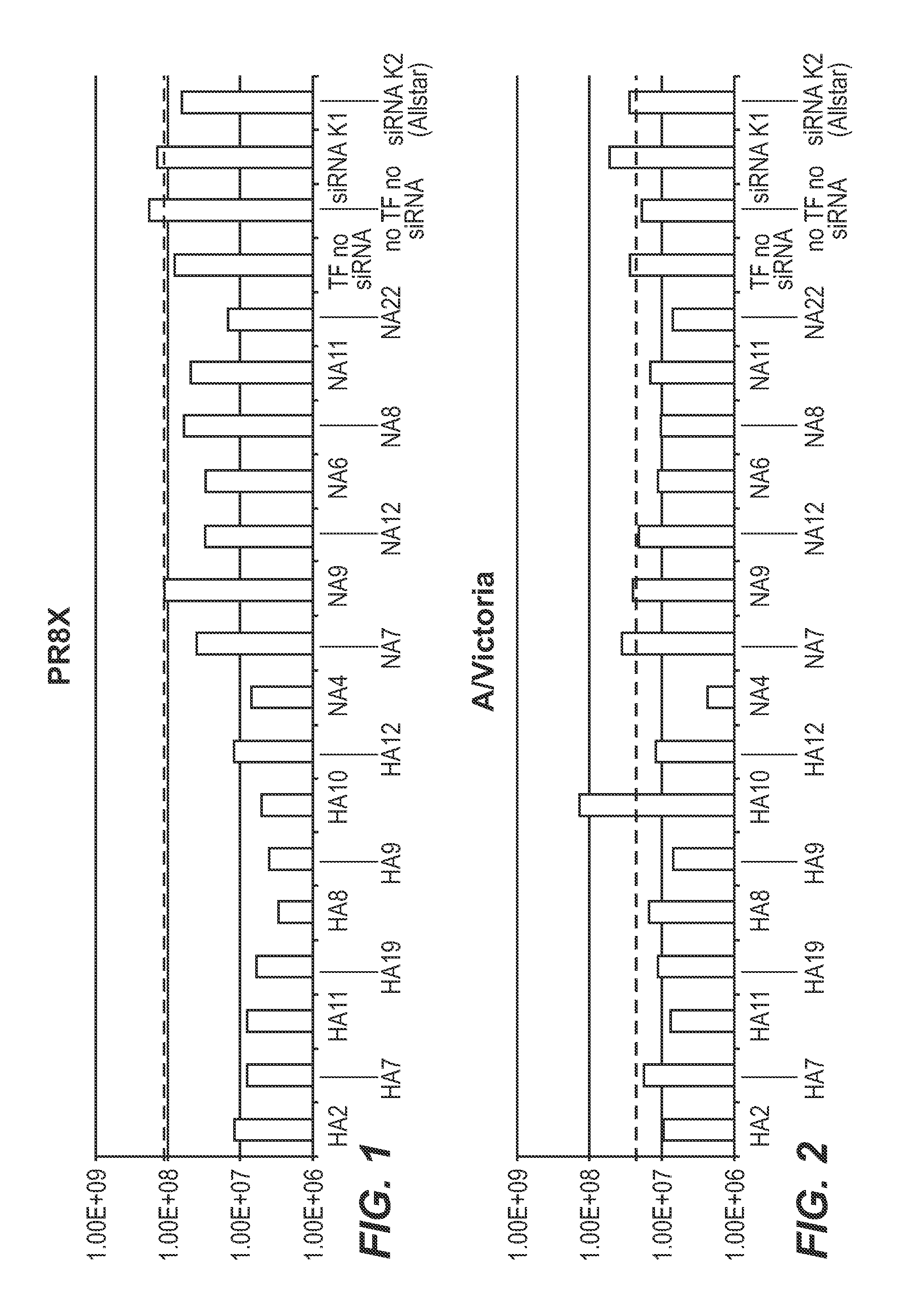Influenza virus reassortment
a technology of influenza virus and reagent, which is applied in the field of influenza virus reagent, can solve the problems of increased risk of introduction of adventitious viral agents and other contaminants, delay in the production of influenza vaccines, and unwanted changes in antigenicity, so as to reduce the transcription and/or translation of the backbone strain's ha, avoid the use of animal derived products, and increase the effect of speed
- Summary
- Abstract
- Description
- Claims
- Application Information
AI Technical Summary
Benefits of technology
Problems solved by technology
Method used
Image
Examples
example 1
[0153]A reassortant influenza virus is produced using the A / PR / 8 / 34 influenza strain as a backbone strain and the A / Brisbane / 10 / 07-like or A / Perth / 16 / 09-like influenza strain as vaccine strain. Inhibitory agents (e.g. siRNAs, PSOs or PMOs) are designed such that they preferentially reduce transcription and / or translation of the HA and / or NA gene(s) of the A / PR / 8 / 34 strain.
[0154]The suitability of the inhibitory agents is tested by introducing the inhibitory agent into a culture host and subsequently co-infecting the culture host with the backbone strain and the vaccine strain. Protein is extracted from the infected cells and the preferential reduction of the backbone strain's HA and / or NA protein levels is assessed by comparing the protein levels of the vaccine strain's and the backbone strain's HA and / or NA proteins by quantitative Western blot analysis.
[0155]Reassortant influenza viruses are produced by introducing the inhibitory agent into the culture host and infecting the cultu...
example 2
[0156]Inhibitory agents of the invention were selected by comparing their effects on the growth of the backbone strain to their effects on the growth of the vaccine strain.
[0157]The following virus strains were tested:[0158]A / PR / 8 / 34 (the backbone strain); and[0159]A / Victoria (H3N2) (the vaccine strain).
[0160]Although they were designed for inhibiting A / PR / 8 / 34 in the presence of A / Perth / 16 / 09, the following siRNAs were tested:[0161]HA2, HA7-HA12 and HA19 from Table 1 (targeting HA); and[0162]NA4, NA6-NA9, NA11, NA12 and NA22 from Table 1 (targeting NA).
[0163]Experimental controls include no treatment (no TF no siRNA), transfection only (i.e. no siRNA; TF no siRNA) and control siRNAs (K1, K2) that do not target the virus.
[0164]The siRNAs were introduced into MDCK cells in parallel experiments. The MDCK cells were subsequently infected with the virus, and the viral titer was measured.
[0165]The results are shown in FIGS. 1 and 2. All tested siRNAs targeting HA show reduction of A / PR / 8...
PUM
| Property | Measurement | Unit |
|---|---|---|
| RG | aaaaa | aaaaa |
| pH | aaaaa | aaaaa |
| pH | aaaaa | aaaaa |
Abstract
Description
Claims
Application Information
 Login to View More
Login to View More - R&D
- Intellectual Property
- Life Sciences
- Materials
- Tech Scout
- Unparalleled Data Quality
- Higher Quality Content
- 60% Fewer Hallucinations
Browse by: Latest US Patents, China's latest patents, Technical Efficacy Thesaurus, Application Domain, Technology Topic, Popular Technical Reports.
© 2025 PatSnap. All rights reserved.Legal|Privacy policy|Modern Slavery Act Transparency Statement|Sitemap|About US| Contact US: help@patsnap.com

